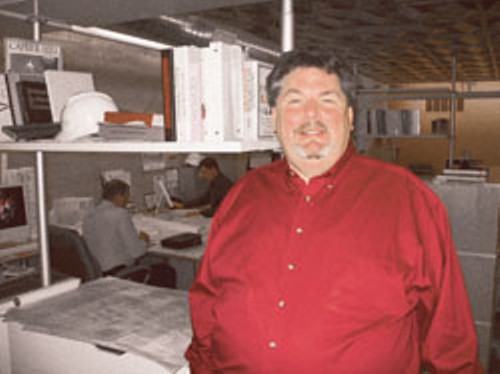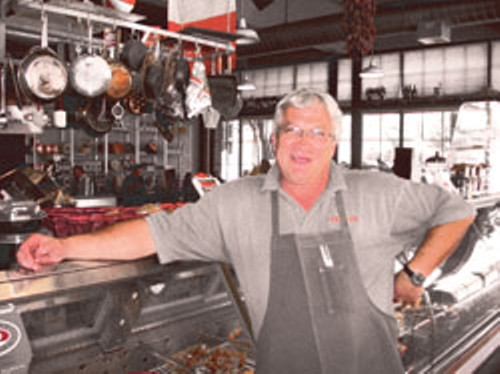Fear and Loafing in Pioneer Park
Politicians, hungry capitalists, crack smokers–all have hope for Pioneer Park.
By Ted McDonoughPage 2 of 3
A Dance Between Gritty and Decay3 p.m. Thursday, Oct. 11: One of the few large groups at the park the day after the stabbing gathers around a stereo balanced on top of a garbage can. Men aged mid-50s through mid-70s sit at a wooden picnic table staring blankly or engaged in muted conversation as a young teenager does a frenzied dance. A man who claims to be a preacher says he’s in the park because he refuses to go into rehab. He begins to recall a quote from Jesus, “The poor will always be with you.” Then the stereo begins to bleat out “Lean on Me,” and the preacher, with everyone else, turns and begins to sing: “We all need somebody to lean on.”
“Pretty urban, huh?” a passing man says, both acknowledging the reporter’s lone white middle-class face in the park and expressing his own delight at the scene.
The supreme irony of Pioneer Park is that it is precisely the area’s urban qualities that draw development.
Architect Ken Millo bought an old tire building at 300 South and 300 West 15 years ago after determining Pioneer Park was one of the few neighborhoods with the potential for anything like city living—“a gritty, downtown living experience that’s not gentrified or suburban.”
"The fact is this is the only neighborhood in all of Salt Lake where we have the potential for the broadest diversity possible, the homeless to very wealthy. To me, that’s the way I want to live,” he says.
Millo and his partner are currently building their second 300 South project, adding 80 condominiums. The new Broadway Park Lofts will include both $500,000 condos and relatively modest $150,000 live-work spaces Millo hopes will attract artists. Next spring, he is set to start construction on a 400 West luxury condo building featuring park views.
About city leaders’ hand-wringing over the park, Millo says, “Frankly, it’s too late.” As more residents and businesses come—many with the help of city subsidies—unsavory aspects of the park will be overwhelmed. “This problem is solved in a few more years,” he says.
City prosecutor Gill warns against too closely connecting the area’s homeless services to park drug activity: Dealers and buyers convene at the park because that’s where the market is, but they come from all over. “The people who might go to the shelter are not necessarily the ones plying a lucrative drug trade,” he says. “If they were, they wouldn’t be staying at the homeless shelter.”
Everyone’s plan for the park
Advocates for the poor who keep tabs on the park, along with the city prosecutor and neighborhood business owners, say Pioneer Park hasn’t suddenly become more dangerous. If anything, it’s milder than it was when former Mayor Deedee Corradini closed the park for three weeks in 1996.
The park’s criminal element is attracting attention today because there are more well-to-do in the area to notice it. The stabbing surprised park neighbors because it happened at night. Tony Caputo, owner of a namesake market and deli on 300 South, says that, unlike when he moved to the neighborhood 10 years ago, “There’s nobody in the park after dark.”
Pioneer Park closes at dusk and doesn’t open again until 7 a.m. Until mid-afternoon, it is nearly empty.
9 a.m. Tuesday, Oct. 9, one day before the stabbings: Ronald Hathaway and his large, red shopping cart piled high with his possessions stuffed inside black garbage bags are among the park’s only silhouettes.
Hathaway—wearing a blue knit cap and cradling a cup of McDonald’s coffee, his gloves beside him on a picnic table—has spent seasons in the park off and on for 16 years. He’s seen the park change from a homeless encampment in the 1980s—when it was a feeding center for waves of newly homeless created by social-service cutbacks of the Ronald Reagan administration—to the shunned island it is today.
“It used to be this park would be covered in blankets,” Hathaway says. By contrast, the second week of October found around 20 to 30 park sleepers per day, mostly around the outskirts.
Hathaway, a one-time long-haul trucker originally from New York, knows the rhythm of surrounding streets, from the timing of deliveries to Aquarius Fish Co. next to Caputo’s, to the progress of condo projects around the park’s edges. He points past Pioneer Park’s west end to the space that used to be the Salvation Army, now a hotel and offices to EnergySolutions. The park is changing, he says.
“They’re going to make a family park here,” Hathaway says, noting city crews work constructing an enclosed dog park. “They’re cleaning out this place.”
A police car speeds quietly onto the grass in the distance. An officer stops a man, orders him to turn out his pockets, then sends him on his way. “Watch,” Hathaway says as the briefly detained man bends down and, with a quick movement, picks something up off the grass.
“There are about four or five more people to get out of here; then they’ll make it a family park,” he says.
Hathaway is certain the people “to get out” include him. He isn’t a drug dealer but is sure that guys with shopping carts are on the list of undesirables. Salt Lake City’s men’s shelter—located northwest of the park—is being moved out by the airport, Hathaway says. “They’re sending three buses in here to take everybody. They don’t want them back here.”
The rumor—that The Road Home shelter is about to exit the neighborhood—is rampant among daytime park dwellers. It isn’t true, according to shelter directors. The shelter has no plans to move, and it has a pledge from city leaders it won’t be forced out.
Glenn Bailey, director of poor-people’s advocacy group Crossroads Urban Center, notes the park’s homeless have survived several “attacks.” He joined those who fought park development proposals—from a museum of 2002 Winter Olympics memorabilia to a wall of jetted water on which movies could be projected. All were misguided efforts, Bailey says, to overwhelm undesirables with “people from Sandy.” If the city is going to subsidize park redevelopment, he says, it should make room for the homeless as well. After all, they were here first.
Perhaps surprisingly, some area businesspeople agree with Bailey. Both Caputo and Millo would be happy to see the drug trade lessened but don’t have a problem with the homeless, or area shelters.
“Once you start to polish, you polish off some of the good,” Millo says. “I don’t want some draconian movement by the city or anybody else to displace these people.”
“The homeless problem is not that they exist; the problem is that they represent too high a percentage of the population. You increase the population of the neighborhood, then it’s not looked at as a homeless neighborhood.”
Caputo predicts Pioneer Park is Salt Lake City’s future center. “I wouldn’t trade my location for anywhere,” he says. “Gateway is a big Disneyland. This is still kind of a neighborhood. You can go out to the corner and holler at guys. The best part is people want you to holler at them here.”
Park neighbors appear to want to live and let live. There is, after all, plenty of room on 10 acres for everyone. But some park users fear the change headed their way is about making Pioneer Park safe only for whitey.
“Not everyone here is doing what they think they’re doing,” says a woman reading City Weekly at a picnic table. Originally from Chicago, she says the park is one of the few places she can see her “people,” by which she means both black and poor.
“They talk about urban renewal. It’s urban removal,” she says. “There are folks living here. There are homeless and poor in every city. They act like homelessness is eight hours a day.”
More by Ted McDonough
-
Chaffetz's Constitution, Health Care Reform, Utah's Economy & Claire Geddes' Return
Congressman Jason Chaffetz, R-Utah, is cosponsoring legislation that would deny citizenship to children born in the United States to noncitizen parents, reversing long-standing law that everyone born in America is a citizen.
- Jul 15, 2009
-
Stimulated
If you don´t like the federal stimulus yet, wait a few months.
- Jul 15, 2009
-
Skinny Utahns, Camp Williams' Data Center & BCS Busters
Utahns are the eighth skinniest people in the country, according to new statistics from the Robert Wood Johnson Foundation.
- Jul 8, 2009
- More »
Latest in Cover Story
Readers also liked…
-
Forget the family pedigree—Robert F. Kennedy Jr should not be the next president of the United States
Trojan Horse
- Jun 21, 2023
-
Women decry harassment and toxic culture at St. George auto dealership
Men at Work
- Oct 11, 2023





